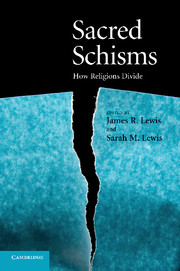Book contents
- Frontmatter
- Contents
- List of figures
- Notes on contributors
- Acknowledgments
- Introduction
- PART I THEORETICAL OVERVIEW
- PART II SURVEY OF SCHISMS IN SELECTED TRADITIONS
- 2 Charismatic authority in Islam: an analysis of the cause of schisms in the ummah
- 3 Schisms in Buddhism
- 4 Schisms in Japanese new religious movements
- PART III CHRISTIAN TRADITIONS
- PART IV WESTERN ESOTERIC TRADITIONS
- PART V NON-WESTERN/POSTCOLONIAL TRADITIONS
- Index
- References
4 - Schisms in Japanese new religious movements
Published online by Cambridge University Press: 24 October 2009
- Frontmatter
- Contents
- List of figures
- Notes on contributors
- Acknowledgments
- Introduction
- PART I THEORETICAL OVERVIEW
- PART II SURVEY OF SCHISMS IN SELECTED TRADITIONS
- 2 Charismatic authority in Islam: an analysis of the cause of schisms in the ummah
- 3 Schisms in Buddhism
- 4 Schisms in Japanese new religious movements
- PART III CHRISTIAN TRADITIONS
- PART IV WESTERN ESOTERIC TRADITIONS
- PART V NON-WESTERN/POSTCOLONIAL TRADITIONS
- Index
- References
Summary
Although controversial, new religious movements in Japan have an aggregate membership of perhaps 10 to 15 percent of the population, in a country where only 30 percent profess religious belief. They are, therefore, important conveyors of the various religious traditions of Japan to members of contemporary society. They also provide a fertile field for exploring the dynamics of schism in Japanese religion. A look at the dynamics of schisms helps to illustrate some characteristics of Japanese religiosity and Japanese society that contribute to the proliferation of these movements in that society in the modern era.
Three groups are identified as being especially fertile in the spawning of break-off groups: Tenrikyo, Omotokyo, and Reiyukai. Often these schismatic groups in turn spawn their own break-offs, leading to a third or even fourth generation of schismatic groups. Below I present representative groups from these three larger traditions, to illustrate some of the dynamics of schism.
TENRIKYO AND ITS OFFSHOOTS
Tenrikyo, founded in 1838, is generally recognized as one of the oldest of the Japanese new religious movements (NRMs). Its founding is traced back to the possession experience of Nakayama Miki (1798–1887), a farmer's wife living in the area of Nara, the ancient capital. After she had already lost two daughters to disease, a yamabushi, or mountain ascetic, was called to cure the injured foot of Miki's son. Since the shamaness, or miko, who would normally accompany the yamabushi and act as his medium could not come, Miki took her place.
- Type
- Chapter
- Information
- Sacred SchismsHow Religions Divide, pp. 83 - 106Publisher: Cambridge University PressPrint publication year: 2009



